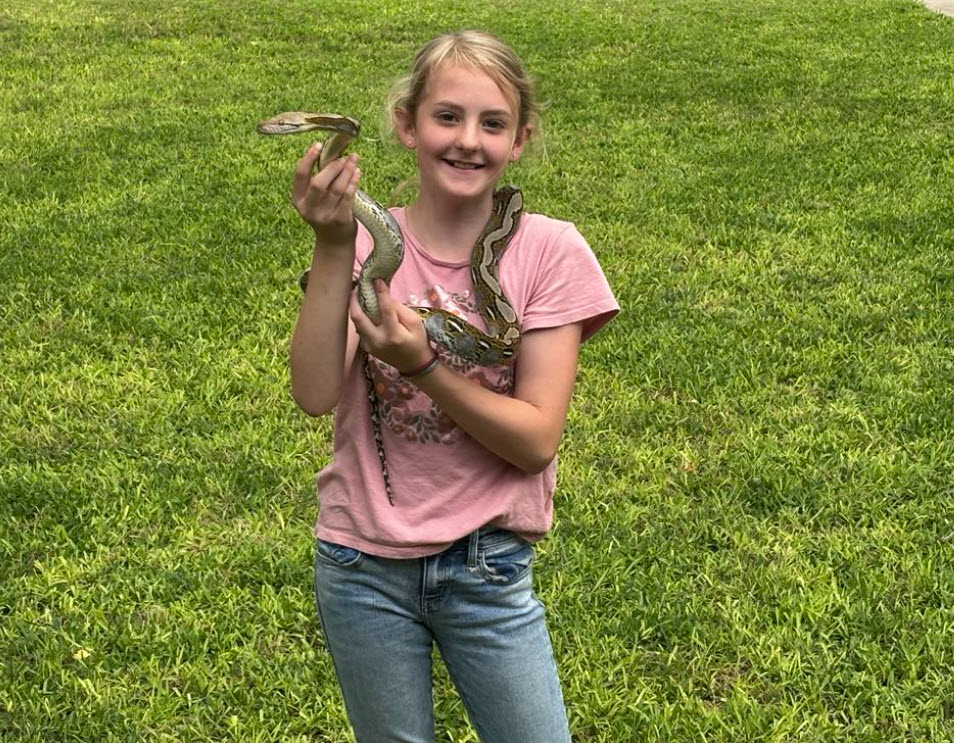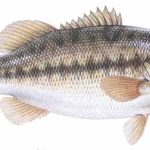Twelve-year-old Alivia Parker isn’t afraid of snakes.
She feeds Xena, her small, reticulated python, defrosted mice and rats every other week and helps care for 25 others who live outside the family home in Canyon Lake.
Snakes are the family business. Alivia’s father, Canyon Lake Fire/EMS Capt. Brett Parker, owns Hill Country Snake Removal, and Alivia is a big part of his growing business.
She helps him catch non-venomous (nobody says ‘poisonous’ anymore) snakes on calls to private properties whose skittish owners want the reptiles removed. She works at her father’s popular snake-information classes around South Central Texas, handling snakes, answering questions, and taking photos for attendees.
Alivia, who is homeschooled, says she likes the money and wants people to know there aren’t that many types of venomous snakes in Comal County.
“There are only five in Canyon Lake or Comal County,” she said. “There are not really a lot of snakes to be afraid of or worried about and the rest of them are all non-venomous.”
Hill Country Snake Removal’s motto is “kill the fear, not the snake.”
Alivia’s great-grandmother inspired that slogan, as well as her grandson’s business.
Brett Parker remembers seeing his grandmother hack a snake to death when he was five years old.
During a visit to her home in Splendora, he watched her take a hoe to a garter snake, chopping it into pieces before announcing that the only good snake was a dead snake.
Horrified, Parker made it his mission to protect snakes from grandma, using sticks (“very carefully”) to pick them up and return them to the woods, out of harm’s way.
Now he makes a little bit of money keeping other snakes alive, responding to calls from people who’ve seen rattlesnakes on their land, and others who just want anything that slithers out of their yards.
Spring and summer are the busiest times of the year for Hill Country Snake Removal, as snakes come out of hibernation and sun themselves on sidewalks, front porches and rocks.
“Always wear shoes,” Parker advises. “…Once you’ve seen the snake, the danger is over. It’s up to you what to do. The biggest thing is don’t get complacent and walk around barefoot thinking ‘there couldn’t be a rattlesnake on my porch.’ You’re in Texas, so there could always be a venomous snake around.”
Take heart — even coiled rattlesnakes aren’t necessarily aggressive, he said. They just want the human to leave.
Unless he can safely relocate captured snakes within a mile of the home where they were found, Parker takes snakes to a property where there are others of the same species.
The good news for many is that recent heavy rains have put a damper on snake sightings.
However, rapid growth in the county is pushing more snakes out into the open. They have no place to go.
“What people don’t realize is, you’re living in Canyon Lake. We live in their home, just like the deer and whatever other animals you’re going to come across,” he said. “You need to understand there being snakes around, you might not want to let your kids run around barefoot, and educate them about native wildlife.”
The question Parker answers the most is, “Are there snakes in the water?”
An avid kayaker and expert on water rescues, Parker’s only seen a few snakes on the lower Guadalupe during his 16 years in Canyon Lake.
Rarely, snakes have been known to swim toward boats to investigate or slither aboard if fish are present.
Don’t panic. Snakes have little interest in people. Anyone who does spot a snake headed their way should make as much commotion as possible.
Snakes are curious creatures. Sometimes, they’re just checking things out.
“One of the biggest problems around this area is when we see a snake in the water, we assume that it’s a cottonmouth or water moccasin when in reality, 99 percent of the time, it’s a non-venomous water snake,” he said.
During classes, Parker teaches residents how to tell from a distance whether a snake is venomous or non-venomous and preaches the truth behind the half-truths of herpetology.
For example, red-touch-yellow is not-a-dangerous-fellow, but the least-dangerous venomous snake in the United States. Real coral snakes who do live in Canyon Lake are shy and actually prefer not to bite. But when they do … chances are the hospital will prescribe little more than pain meds.
The Canyon Lake firefighter, who recently developed a continuing-education class about snakes for first responders, said there’s no need to call an ambulance if you’re bit by a snake. Just get in the car and have someone drive you directly to the emergency room.
“Do not drive yourself to the emergency room.”
Don’t cut, suck, or apply a tourniquet. Snake-bite kits are useless, as are tasers, tobacco and basil.
There’s no need to catch the snake, either. The same antivenom is used to treat almost all snake bites.
Parker said just because you see one snake doesn’t mean there are more unless there are baby snakes. They can be quicker to bite, but they are 100% capable of controlling their body.
“Quantity matters, and adult venomous snakes can literally have 100 times more venom than a juvenile.”
Snake Away is a joke, and mothballs are extremely harmful to the ground, domestic animals, wild animals, children, and don’t bother snakes at all. Soap, sulfur, essential oils, glass, and eggshells do nothing to keep away snakes.
Smells don’t bother them at all.
To learn more or to as Parker likes to call it, “kill the fear, not the snake,” visit Hill Country Snake Removal’s Facebook page.
At his classes, expect live snakes and learn common myths about snakes, how to identify them from a safe distance, and what to do if you see one in your front yard.
“After this course, you will understand the vital role that snakes play in our ecosystem, and what not to do in the event of a venomous snakebite,” he said




